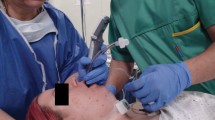Abstract
This report describes the anesthetic management of an obese patient with a difficult airway and the merits of videolaryngoscopy, specifically in terms of the reduced risk of dental damage during intubation. A 49-year-old woman (body mass index; BMI, 36 kg·m−2), was scheduled to undergo an elective laparoscopic cholecystectomy because of cholelithiasis. Based upon the obesity of the patient and preoperative metrics (Mallampati grade IV; interdental distance of 2.9 cm; thyromental distance, 5.5 cm) a difficult airway was anticipated. Classic direct laryngoscopy using a Macintosh blade size IV failed, despite three intubation attempts—each resulting in a Cormack-Lehane grade IV view. Intubation using a video-assisted Macintosh laryngoscope (V-Mac; Karl Storz, Tuttlingen, Germany) was successful upon the first attempt. The maximum force exerted on the patient’s maxillary incisors was 61 N by direct laryngoscopy and 7.6 N using the indirect videolaryngoscope, both using a Macintosh blade.
Similar content being viewed by others
References
Cooper RM. Use of a new videolaryngoscope (GlideScope) in the management of a difficult airway. Can J Anaesth. 2003;50:611–613.
Cooper RM, Pacey JA, Bishop MJ, McCluskey SA. Early clinical experience with a new videolaryngoscope (GlideScope) in 728 patients. Can J Anaesth. 2005;52:191–198.
Kaplan MB, Hagberg CA, Ward DS, Brambrink A, Chhibber AK, Heidegger T, Lozada L, Ovassapian A, Parsons D, Ramsay J, Wilhelm W, Zwissler B, Gerig HJ, Hofstetter C, Karan S, Kreisler N, Pousman RM, Thierbach A, Wrobel M, Berci G. Comparison of direct and video-assisted views of the larynx during routine intubation. J Clin Anesth. 2006;18:357–362.
Kaplan MB, Ward D, Hagberg CA, Berci G, Hagiike M. Seeing is believing: the importance of video laryngoscopy in teaching and in managing the difficult airway. Surg Endosc. 2006;20Suppl 2:S479–S483.
Shippey B, Ray D, McKeown D. Case series: the McGrath videolaryngoscope—an initial clinical evaluation. Can J Anaesth. 2007;54:307–313.
Cormack RS, Lehane J. Difficult tracheal intubation in obstetrics. Anaesthesia. 1984;39:1105–1111.
Lee A, Fan LT, Gin T, Karmakar MK, Ngan Kee WD. A systematic review (meta-analysis) of the accuracy of the Mallampati tests to predict the difficult airway. Anesth Analg. 2006;102:1867–1878.
Mallampati SR, Gatt SP, Gugino LD, Desai LD, Waraksa B, Freiberger D, Liu PL. A clinical sign to predict difficult tracheal intubation: a prospective study. Can Anaesth Soc J. 1985;32:429–434.
Lee RA, van Zundert AAJ, Maassen RLJG, Willems RJ, Beeke LP, Schaaper JN, van Dobbelsteen J, Wieringa PA. Forces applied to the maxillary incisors during video-assisted intubation. Anesth Analg. 2009;108:187–191.
Brodsky JB, Lemmens HJM, Brock-Utne JG, Saidman LJ, Levitan R. Anesthetic considerations for bariatric surgery: proper positioning is important for laryngoscopy. Anesth Analg. 2003;96:1841–1842.
Rich JM. Use of an elevation pillow to produce the head-elevated laryngoscopy position for airway management in morbidly obese and large-framed patients. Anesth Analg. 2004;98:264–265.
Knill RL. Difficult laryngoscopy made easy with a “BURP”. Can J Anesth. 1993;40:279–282.
Takahata O, Kubota M, Mamiya K, Akama Y, Nozaka T, Matsumoto H, Ogawa H. The efficacy of the “BURP” maneuver during a difficult laryngoscopy. Anesth Analg. 1997;84:419–421.
Van Zundert A, Stessel B, De Ruiter F, Giebelen D, Weber E. Video-assisted laryngoscopy: a useful adjunct in endotracheal intubation. Acta Anaesthesiol Belg. 2007;58:129–131.
Bucx MJ, Snijders CJ. Force, torque, and stress relaxation with direct laryngoscopy. Anesth Analg. 1996;83:1130–1131.
Bucx MJ, van der Vegt MH, Snijders CJ, Stijnen T, Wesselink PR. Transverse forces exerted on the maxillary incisors during laryngoscopy. Can J Anaesth. 1996;43:665–671.
Suzuki A, Abe N, Sasakawa T, Kunisawa T, Takata O, Iwasaki H. Pentax-AWS (Airway Scope) and Airtraq: big difference between two similar devices. J. Anesth. 2008;22:191–192.
Hirabayashi Y, Seo N. Airway Scope: early clinical experience in 405 patients. J Anesth. 2008;22:81–85.
Suzuki A, Terao M, Aizawa K, Sasakawa T, Henderson JJ, Iwasaki H. Pentax-AWS Airway Scope as an alternative for awake flexible fiberoptic intubation of a morbidly obese patient in the semi-sitting position. J Anesth. 2009;23:162–163.
Snider DD, Clarke D, Finucane BT. The “BURP” maneuver worsens the glottic view when applied in combination with cricoid pressure. Can J Anaesth. 2005;52:100–104.
Takahata O, Kubota M, Mamiya K, Akama Y, Nozaka T, Matsumoto H, Ogawa H. The efficacy of the “BURP” maneuver during a difficult laryngoscopy. Anesth Analg. 1997;84:419–421.
Givol N, Gershtansky Y, Halamish-Shani T, Taicher S, Perel A, Segal E. Perianesthetic dental injuries: analysis of incident reports. J Clin Anesth. 2004;16:173–176.
Warner ME, Benenfeld SM, Warner MA, Schroeder DR, Maxon PM. Perianesthetic dental injuries: frequency, outcomes, and risk factors. Anesthesiology. 1999;90:1302–1305.
Newland MC, Ellis SJ, Peters KR, Simonson JA, Durham TM, Ullrich FA, Tinker JH. Dental injury associated with anesthesia: a report of 161 687 anesthetics given over 14 years. J Clin Anesth. 2007;19:339–345.
Author information
Authors and Affiliations
About this article
Cite this article
Maassen, R., Lee, R., van Zundert, A. et al. The videolaryngoscope is less traumatic than the classic laryngoscope for a difficult airway in an obese patient. J Anesth 23, 445–448 (2009). https://doi.org/10.1007/s00540-009-0780-1
Received:
Accepted:
Published:
Issue Date:
DOI: https://doi.org/10.1007/s00540-009-0780-1




